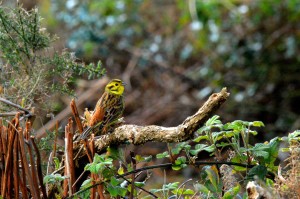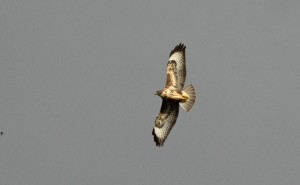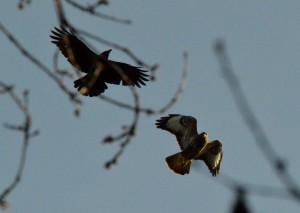- The remarkable bird life of the Wakatobi Islands, SE Sulawesi: hidden endemism and threatened populations - 10/07/2020
- The Bird Life of Wawonii and Muna Islands Part I: biodiversity recording in understudied corners of the Wallacea region - 30/06/2020
- Comparing the biodiversity and network ecology of restoredand natural mangrove forests in the Wallacea Region. - 09/12/2019
On Wednesday January 14th the Pat Kenny show on Newstalk radio station hosted Professor Luke O’Neill (a prominent Trinity College Dublin Immunologist), in a segment exploring the causes of the huge declines seen in European bird populations newstalk.ie/player/podcast. Comments from both Professor O’Neill and Mr. Kenny implicating raptors and corvids in these bird declines provoked a storm on social media. Every Irish environmental NGO has strongly condemned these implications. Professor O’Neill was not in possession of the full facts and has apologised*. Predatory birds are not responsible for severe declines in many bird populations [1] and here at TCD EcoEvo we lay out the real reasons for these declines and show why natural predators like Red Kites, White-tailed Sea-eagles and Golden Eagles are in fact of huge benefit to ecosystems.
There’s no doubt that many bird populations are declining at an astonishing rate. An estimated 421 million individuals have been lost from the populations of 144 species over 30 years between 1980 and 2009 [2]. While the rarest European species have increased in population due to intensive conservation efforts, previously common species have experienced massive population declines. Though most of these species are not in imminent danger of extinction their decrease is a worrying sign of the poor health of the European environment. These previously common species are also vitally important in the provision of ecosystem services, such as scavenging and keeping rodent and insect populations in check.
Multiple causes have contributed to bird population decline, but the most important reason is destruction of bird habitats through land use change. As natural habitats have been lost to human development and agriculture has intensified, bird populations have suffered. Many of the species which have suffered most are traditional farmland birds such as Corncrakes, Yellowhammers and Corn Buntings (declared extinct as a breeding bird in Ireland [3]), though declines have been seen across the board. Unfortunately there is no simple solution to this problem. A widespread shift in public mentality to place more value on our natural heritage is likely needed to pressurise legislators to make real progress on environmental issues. In the short term, more engagement with farmers and improvement of incentives such as the tweaking of rural environment funding schemes to enable protection of hedgerows and management of unproductive marginal areas for wildlife, could release pressure on some of the worst affected species.

Increased pressure from natural predators is not thought to be a major factor driving the decline in bird populations. In the largest study of its kind, Newson et al. (2010) [1] found no evidence that population increases in avian predators were associated with large-scale population declines in the majority of songbird species. The predators singled out as causes of bird declines on Newstalk, corvids and large raptors, were not considered to have had any significant effect.
Corvids (the crow family) as a group have commonly received a largely unfair vilification. While they can certainly cause localised declines in songbirds, there’s no evidence of them causing widespread declines. Their increase in numbers is due to human modification of the environment. Their adaptability means they do well in the highly fragmented habitat we have created, filled with discarded food and road kill carrion. The increase in corvid numbers is just another symptom of the poor health of the environment, not the cause.
Due to widespread persecution, large raptors were almost completely absent from Ireland by the early 20th century. The reintroductions undertaken by the Golden Eagle Trust of the Golden Eagle (starting 2001), White-tailed Sea-eagle and Red Kite (both in 2007), along with the dramatic recovery in Buzzard numbers across the island of Ireland, has gone some way to redressing this balance. Predators, such as these birds, play an incredibly important role in structuring and maintaining stability in ecological communities [4]. None of Ireland’s large raptors are thought to be making a significant impact on any declining bird species. Buzzards and Golden Eagles are noted predators of corvids and compete with them for carrion. They also have a behavioural effect on corvids, forcing them to spend time being vigilant for aerial predators, reducing their foraging efficiency. Apex predators provide a major benefit to the ecosystem by controlling medium sized predators in this way.

Ireland’s avian predators contribute key services to the Irish ecosystem. Raptors, along with corvids, carry out the vital role of cleaning up the ample carrion produced by animals hit on our roads, removing carcasses which could harbour disease. The Red Kite is particularly adept at this role as, despite well publicised misconceptions, it is much more of a scavenger than a hunter. Considering these potential benefits, and the absence of any evidence linking our avian predators to a decline in bird populations, these species are rightly legally protected from culling [5,6]. This protection is particularly vital, as despite the recovery of large raptors in Ireland we still have a long way to go compared to other European countries. Red Kite and eagle populations in Ireland are extremely localised and small while the Buzzard has yet to re-colonise large parts of the country. Hopefully with continued support they will go on to establish stable breeding populations in the coming years.
Biased perception can promote persecution and needless vilification, especially of predators. Thankfully the outdated concept that man will somehow bring balance to the environment by killing off natural predators seems to be on the wane. This week’s social media storm certainly showed that attitudes towards raptor conservation have come a long way. Predators need to be appreciated as vital parts of a functioning ecosystem. They also deserve to be appreciated as incredible animals worthy of our affection. Anyone who has stopped to observe the ingenuity of a foraging Magpie or observed the incredible dynamism of a Golden Eagle in flight will know that these are exceptional animals which we are privileged to have gracing the Irish landscape.
Luke O’Neill would like to add that he apologises unreservedly for the errors he made in the interview on the Pat Kenny show and regrets any harm he might have caused to raptor conservation efforts.
Authors
Darren O’Connell, Andrew Power, Nicola Marples, Andrew Jackson, Yvonne Buckley (Chair of Zoology), EcoEvo@TCD
Photo credit
Darren O’Connell and Andrew Power
References
[1] Newson, S.E., Rexstad, E.A., Baillie, S.R., Buckland, S.T. and Aebischer, N.J. (2010) Population change of avian predators and grey squirrels in England: is there evidence for an impact on avian prey populations? Journal of Applied Ecology, 47: 244-252.
http://onlinelibrary.wiley.com/doi/10.1111/j.1365-2664.2010.01771.x/abstract
[2] Inger, R., Gregory, R., Duffy, J.P., Stott, I., Voříšek, P. and Gaston, K.J. (2015) Common European birds are declining rapidly while less abundant species’ numbers are rising. Ecology Letters, 18: 28-36.
http://onlinelibrary.wiley.com/doi/10.1111/ele.12387/abstract
[3] Balmer, D., Gillings, S., Caffrey, B., Swann, B., Downie, I. and Fuller, R. (2013) Bird Atlas 2007-11: the breeding and wintering birds of Britain and Ireland. HarperCollins, UK.
[4] Estes, J.A., Terborgh, J., Brashares, J.S., Power, M.E., Berger, J., Bond, W., Carpenter, S.R., Essington, T.E., Holt, R.D., Jackson, J.B.C., Marquis, R.J., Oksanen, L., Oksanen, T., Paine, R.T., Pikitch, E.K., Ripple, W.J., Sandin, S.A., Scheffer, M., Schoener, T.W., Shurin, J.B., Sinclair, A.R.E., Soulé, M.E., Virtanen, R. and Wardle D.A. (2011) Trophic downgrading of planet Earth. Science, 333: 301-306.
http://www.sciencemag.org/content/333/6040/301.full.html
[5] Wildlife Act, 1976, Wildlife (Amendment) Act, 2000, and Wildlife (Amendment) Act, 2012. Stationery Office, Dublin, Ireland.
http://www.irishstatutebook.ie/2012/en/act/pub/0029/index.html
[6] Council Directive 2009/147/EC of the European Parliament and of the Council of 30 November 2009 on the conservation of wild birds.
http://eur-lex.europa.eu/legal-content/EN/TXT/?uri=CELEX:32009L0147



3 Replies to “Predators: feathered friend or foe?”